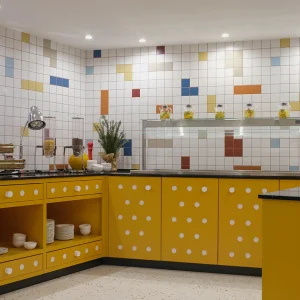
In the past couple of years new children’s healthcare schemes have emerged that demonstrate how very seriously healthcare providers now take this patient group – and their carers – as well as how far design has come in the engineering of healthcare spaces that reassure and support their occupants.
So how can architects and designers deliver quality learning environments in the new regime of austerity in education buildings? In the Michael Gove era it’s clear that the days of generously proportioned, new-build schools are largely finished. Instead, in a backlash to the perceived indulgence of aspects of the Building Schools for the Future programme, it’s a matter of cheaper (by 30 per cent), smaller (by 15 per cent) and quicker (just six weeks’ client engagement).
Yet at the same time as the cuts, new research by the University of Salford and IBI Nightingale, a specialist in healthcare architecture, suggests that the design of the classroom environment can affect pupil performance by as much as 25 per cent.
‘It’s like someone has turned off the light,’ says Walters and Cohen Architects’ director Michál Cohen of the Government’s new attitude towards school design. She is concerned that cuts to budgets and space mean that any area not considered to be academic – such as circulation and social space – will potentially be compromised. ‘I don’t know how we’ll find space for people to learn how to be good members of our community, and how to relate properly to one another,’ she says.
No one is saying that BSF was perfect, nor that it isn’t possible to meet the new budgets. But with half the savings coming from less space and the other half from construction costs, average build costs will significantly change from about £2,200 per sq m to nearer £1,500-£1,700 per sq m.
Aside from the quality of learning environments this new regime will result in, the worry is that by working to such reduced budgets to replace often poorly built, largely post-war buildings, design teams are merely creating another generation of buildings that will themselves be ripe for overhaul sooner rather than later.
There is still plenty of work to bid for, albeit to tighter schedules and budgets, and with the prospect of a greater emphasis on standardised school designs for new builds. All in all it’s likely that refurbishment and ingenious intervention, rather than more lavish rebuilding projects, will be increasingly the way forward. Those practices that prove themselves able to get a lot out of a little are needed more than ever to wring as much quality of possible out of the brief.
‘Where there’s less money to go around, a more critical analysis of buildings can show that you can get more out of existing buildings,’ says Roger Hawkins of architecture practice Hawkins Brown, adding that under BSF some ‘pretty good buildings’ were demolished. ‘Creative reuse of existing buildings can generate good-quality school buildings. You need to have flexibility and be very thorough in your investigations. That’s good work for architects,’ he says.
Architecture and design firm Jestico + Whiles, which has 10 to 15 school projects on the go at various stages, is under no illusions about the task of achieving quality school environments, but won’t let that stop it trying. ‘Without doubt it’s extraordinarily challenging and difficult to handle…
In the hands of some contractors driving for the lowest costs, the outcomes could be worrying. We felt we could make a difference so we are carrying on,’ says associate director Ben Marston. ‘It is possible. Never say never!’ adds Michál Cohen. ‘Really clever use of existing space is invaluable in this day and age.’
On these pages we take a look at five projects that demonstrate how reworking existing school campuses, rather than demolishing everything and starting again, can still transform the school experience for both pupils and staff alike.
Park View, Birmingham
Architect: Haworth Tompkins
Completed last autumn, the Park View school is one of the last of the BSF school rebuilding programme. At £8m it is not one of the more lavish examples of the era, having suffered a 10 per cent budget cut and retaining much of the Sixties’ school’s fabric and reworking it. To make matters even more challenging, a quarter of the budget was unexpectedly taken up by the unforeseen need to rebuild the sports hall.
Haworth Tompkins’ interventions demonstrate that there is still scope to radically change an existing school without rebuilding. The main priorities were improving the entrance, which had no street presence, and addressing the poor circulation and sports facilities. The design team’s key move was harnessing an underused central courtyard and making this the social and spiritual heart of the school, creating a semi-cloister around the edge with circulation at both lower and upper level, where it takes the form of a covered walkway. These new interventions are clad in larch and link into a new entrance walkway. The dining hall opens on to this space, with new classrooms above.
New breakout spaces, or ‘social learning zones’, give areas for independent student work. A new, timber-clad sports hall addresses the specific needs of the 99 per cent Muslim pupil population, including separate sports and ablutions facilities for girls and boys.
‘There was a lot of reorganisation, making what they had work more efficiently,’ says Haworth Tompkins’ managing director Toby Johnson. ‘The form of the building is pretty much the same. The interventions are limited but hugely effective in transforming how the school uses the building it had before.’
The budget – half the cost of a rebuild – didn’t allow for as much work to the building envelope as would have been desirable. So the priority was to make the school ‘safe, warm and dry’, with work concentrated on a new roof rather than window replacement, which will be addressed in future maintenance.
Such a result, says Johnson, could only be achieved through careful collaboration between contractor, school and architect to achieve a bespoke solution that makes the most of the limited resources.
St Michael’s Catholic College, London
Architect: De Matos Ryan
Some relatively newly completed BSF-procured schools are alreadt being adjusted to better suit school needs. These include St Michael’s, which completed just two years ago but had a number of problem spaces that needed addressing including the library, a lecture hall and an underused cafe.
Architect and designer De Matos Ryan was brought in by education consultant Bryanston Square to work with the school. In order to speed the project up, the work did not interfere with the fabric of the building, since this would risk invalidating warranties that were part of the PFI-procured original build. In this way, says Jose Esteves de Matos of De Matos Ryan, the school can take control over its limited budget and use it rather than wasting it on the process.
The library lacked its own identity and was not maximised as a proper learning space. The architecture practice used the bookshelves to form a natural perimeter and introduced new furniture, colours and finishes to create a new identity.
The library is now very popular, as is the revamped cafe. This little-used facility for the sixth form was overhauled to give it its own character and provide different types of seating, including booths, shared and smaller tables so that staff could use it for meetings too.
‘It is possible to identify the problem, design a solution and implement it. It doesn’t have to take forever to achieve. A small budget can make a difference,’ says Esteves de Matos.
Eltham hill School, London
Architect: Hawkins Brown
Eltham Hill School in south-east London is being transformed by a £20m refurbishment and partial new build that has significantly reduced costs by avoiding a decant.
While the original Twenties’ school is being refurbished, a Sixties addition has been demolished to make way for a new, brick-clad, three-storey school block organised around a top-lit central circulation space with break-out areas and bright seating. Walls are decorated by designs developed with pupils, who also collaborated on new carpets in both the new and refurbished Twenties’ block. This sort of bespoke design was possible under BSF, but, says Roger Hawkins, is unlikely to take place in the new low-cost era of school design.
A new landscaped courtyard is overlooked by a new dining hall. The project, which also includes a new sports hall., will be completed by the autumn.
Stour Valley Community School, SuffoLk
Architect: Jestico + Whiles
Under the previous BSF regime, Stour Valley may have been a candidate for wholesale demolition and replacement. Instead, architect Jestico+ Whiles worked with a £4.8m budget on a refurbishment and reworking of the school buildings from the Fifties and Eighties, creating a new entrance and adding new science laboratories plus a first floor link between the original building and the extension.
A key intervention was the carving out of a new ‘heart space’ off of the entrance. This double-height space creates a breakout area and makes a feature of the level change by encouraging pupils to sit on the steps. Natural daylight is introduced to improve the ambience of the space.
‘Even small changes can make a big difference,’ says associate director Jude Harris.
Completed in time for the beginning of the new school year last autumn, it delivers a 20 per cent saving on energy costs despite a 20 per cent increase in overall floor area.
Towers Junior School
Architect: Walters & Cohen
Towers suffered from classrooms that were too small. But instead of simply extending each classroom, Walters & Cohen’s interventions – which cost just £1.8m – took a different approach and instead created two new central ‘heart’ spaces to link the surrounding classes, using existed but under-utilised shared spaces within the school plan.
These new central spaces include space for ICT, presentations, science, wet and resource areas. Pupils can use the space for individual or group work after being briefed in the main classroom, thus increasing scope for different ways of teaching and learning.
The revamp also created a more welcoming entrance as well as new art, music and animation rooms.
‘Working with very little new building and coming inwards not outwards we gave them more than they ever dreamed of,’ says Michál Cohen.
Sensory impacts on learnIng
New research into the impact of classroom design on the academic performance of primary school children has found that the classroom environment can affect academic progress by up to 25 per cent.
The research, by the University of Salford and architecture practice IBI Nightingale analysed progress of pupils in seven Blackpool primary schools, taking into account issues of classroom orientation, natural light, noise, temperature, air quality, colour and flexibility of space.
It found that 73 per cent of the variation in pupil performance can be explained by the building environment, and that the progress of pupils placed in the least-effective environment could be affected by as much has the average improvement across one year. Two of the most influential factor were colour and connectivity, suggesting that children appreciate circulation routes that are more than narrow, clear corridors.
Richard Mazuch, director of design research and innovation at IBI Nightingale, says the findings offer a good checklist for aspects of design beyond space and massing, such as colour, and adds that consideration of these issues is entirely compatible with constrained budgets. ‘A lot are fairly light-touch design interventions that can make a big difference,’ he says.
The pilot research is now being followed by a second study of 20 schools involving 5,000 children.





